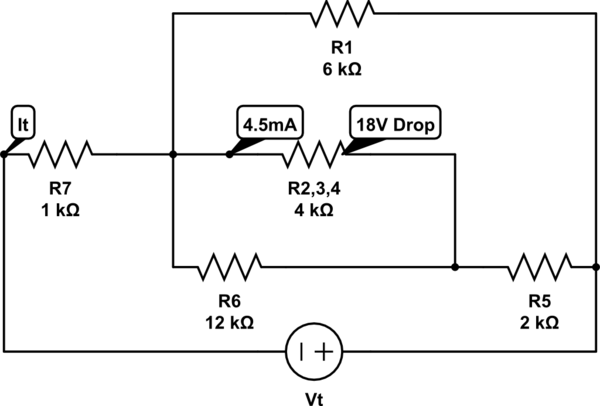Well, I just calculated the currents and voltages and I get the same results as you quote. So how did I work it all out? Well, let's re-draw your circuit with better labels, and reduce it as we go. We start with:

simulate this circuit – Schematic created using CircuitLab
Ok, so we know 3mA flows through R2, which is 3000Ω. So the voltage across that resistor must be \$V=IR = 0.003×3000 = 9V\$. So there must also be 9V across R3 since it's in parallel. So \$I=\frac{V}{R} = \frac{9}{6000} = 1.5mA\$.
So R4 must be having the current that is through both R2 and R3, which is 3mA + 1.5mA, so 4.5mA. Again, V=IR, so 0.0045 / 2000 = 9V over R4.
Ok, so let's simplify. Across R2||R3 is 9V, and across R4 is 9V, so across the lot there must be 18V:

simulate this circuit
Moving on... Your 18V known drop now also lies across R6, which is 12K. So that must have 1.5mA flowing through it. So what current flows through R5? The sum of R6 and R2,3,4's currents of course, which is 4.5+1.5 = 6mA.
So now we can work out the voltage drop across that resistor at V=IR = 0.006×2000 = 12V. Therefore the voltage drop across the whole middle mess must be 18+12 = 30V. Time to simplify again:

simulate this circuit
Ok, so we're now seeing a pattern. The voltage drop we just worked out is now obviously across R1 as well, at 6KΩ, so I=V/R = 30 / 6000 = 5mA. And again we sum the two branches to see what flows through R1. And that's 11mA (5+6). 11mA through a 1KΩ resistor is 11V. Shall we simplify one last time just for fun?

simulate this circuit
Ok, now it is obvious that \$I_T\$ is 11mA since that current must flow through both resistors. One answer now complete.
And the voltage must be the sum of the voltages dropped across the two resistors. 30+11 is 41V. Second answer done!
And for further confirmation, the total resistance is 2727.2727... + 1000 = 3727.2727..., and what else is 3727.2727...? 41/11 of course!
Doing this kind of circuit analysis is very much like doing a Sudoku. You have a few initial clue values, which lead to a few more values that you can infer from them. Those values in turn lead to more values, and so on, until you have filled out the whole grid.





